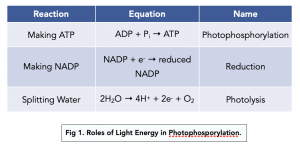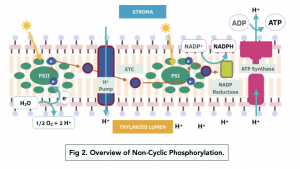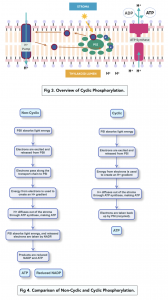Cyclic and Non-Cyclic Phosphorylation (A-level Biology)
Cyclic and Non-Cyclic Phosphorylation
Types of Phosphorylation
During the light-dependent reactions of photosynthesis, there is photoionisation of chlorophyll due to absorption of light energy. The light energy is essential for photosynthesis to happen. The energy has several roles:

There is both cyclic and non-cyclic photosphorylation, as we’ll discover below.
Non-Cyclic Phosphorylation
The light dependent reaction of photosynthesis takes place within the thylakoid membrane of chloroplasts within plant cells of the leaf. In this section we will break this process into three stages.
The thylakoid consists of many photosystems, with electron carrier proteins in between. The carriers transport electrons between photosystems. Together the photosystems and electron carriers are called the electron transport chain.
Stage 1:
1. Photosystem II absorbs light. The light-absorbing complexes and associated chlorophyll in Photosystem II (PSII) absorb light energy.
2. Electrons are excited, released and transported to Photosystem I. The light energy is used to excite electrons and raise them to a higher energy level. The electrons are released from chlorophyll (photoionisation of chlorophyll), and electron carriers transport the electrons from the chlorophyll, and along the thylakoid membrane to Photosystem I (PSI).
3. Photolysis of water replaces the lost electrons. The light energy is also used to carry out photolysis, which splits a water molecule. Photolysis releases:
Two H+ ions – these can take part in chemiosmosis to produce ATP (see below), and eventually are taken up by NADP to make reduced NADP.
Two electrons – these replace the lost electrons which have gone to PSI
- O2 – this is a product of photosynthesis. It could be used in aerobic respiration, but normally diffuses out through the stomata.
Stage 2:
4. Electrons are carried from PSII to PSI. There are several electron carriers (you don’t need to memorise the names), so electrons are passed from carrier to carrier. Each time the electron moves down the electron transport chain, there is a release of H+ and the electron loses some energy along the way.
5. H+ is actively transported from the outside through the thylakoid membranes. The energy lost from the electrons is used to actively transport H+ from the outside and into the thylakoid membranes. An H+ gradient is created from the thylakoid membranes (high H+) to the stroma (low H+), so H+ diffuses into the stroma.
6. ATP synthase transports H+ back out of the chloroplast. The enzyme ATP synthase transports H+ from the stroma to the outside of the chloroplast. The H+ is used to catalyse conversion of ADP + Pi → ATP. This process is known as non-cyclic photophosphorylation.
7.. The electron transport chain theory above is called chemiosmotic theory. In simple terms, it is the theory that ATP synthesis is driven by an H+ gradient across the thylakoid membrane.
Stage 3:
8. PSI also absorbs light energy. PSI also absorbs light energy, which leads to loss of a pair of electrons. The electrons from PSII replace these lost electrons in PSI, and remember that photolysis of water replaced the lost electrons from PSII.
9. Reduced NADP is made. The electrons released by PSI are used in a reduction reaction, converting NADP to reduced NADP.

Cyclic Photophosphorylation
In non-cyclic photophosphorylation, we saw that electrons were released from PSII and passed to PSI, where they were used to generate ATP. Finally, the electrons were given to NADP to make reduced NADP.
Alongside this, some ATP is made in cyclic photophosphorylation. This just involves PSI, and has a similar mechanism. Light energy excites electrons, and energy is used to create an H+ gradient in the same way, with ATP synthase transporting H+ out of the stroma. Less ATP is made via cyclic photophosphorylation, but importantly the electrons aren’t given to NADP. Therefore the process is cyclic – the electrons are recycled.

Overall
In total, the light dependent reaction produces 2 molecules of ATP and 2 molecules of NADPH.
FAQs
Cyclic phosphorylation is a process in cellular respiration in which a molecule of adenosine diphosphate (ADP) is converted into adenosine triphosphate (ATP) through a series of chemical reactions in a cyclic manner.
Cyclic phosphorylation involves the movement of electrons along the electron transport chain in the mitochondria, which generates a proton gradient that drives the production of ATP through the action of the ATP synthase enzyme.
Non-cyclic phosphorylation, also known as linear or oxidative phosphorylation, is the process of generating ATP through the transfer of electrons from NADH and FADH2 to oxygen in the mitochondria. This process also generates a proton gradient which drives ATP production.
In non-cyclic photophosphorylation, both photosystem I (PSI) and photosystem II (PSII) are involved in a linear electron flow that results in the production of ATP and NADPH. The process can be summarized in the following steps:
Light energy is absorbed by the pigments in PSII, exciting electrons to a higher energy level. These high-energy electrons are then passed through an electron transport chain (ETC) to PSI, releasing energy that is used to generate a proton gradient across the thylakoid membrane.
Water molecules are split by PSII, releasing electrons, protons (H+), and oxygen gas. The electrons from water replace the high-energy electrons lost by PSII and are passed through the ETC to PSI.
The high-energy electrons from PSI are used to reduce NADP+ to NADPH, which is used as a reducing agent in the light-independent reactions of photosynthesis.
The proton gradient generated by the ETC is used by ATP synthase to generate ATP from ADP and inorganic phosphate.
Overall, non-cyclic photophosphorylation produces both ATP and NADPH, which are used in the Calvin cycle to convert CO2 into organic compounds such as glucose.
In A-level Biology, photophosphorylation is the process by which light energy is used to produce ATP, the energy currency of cells. There are two types of photophosphorylation that occur during photosynthesis in plants: cyclic and non-cyclic photophosphorylation.
Non-cyclic photophosphorylation involves both photosystem I (PSI) and photosystem II (PSII) in a linear electron flow that results in the production of ATP and NADPH. In this process, water is split by PSII, releasing oxygen and hydrogen ions. Electrons are transferred from PSII to PSI via an electron transport chain, which generates a proton gradient across the thylakoid membrane. This gradient is used to drive the synthesis of ATP by ATP synthase, while NADP+ is reduced to NADPH by electrons from PSI.
In cyclic photophosphorylation, only PSI is involved in a circular electron flow that generates ATP but not NADPH. Electrons from PSI are cycled back to PSI via an electron transport chain, which generates a proton gradient that is used to produce ATP by ATP synthase. Since no electrons are transferred to NADP+, no NADPH is produced during cyclic photophosphorylation.
Overall, the main difference between cyclic and non-cyclic photophosphorylation is the involvement of both PSII and PSI in non-cyclic photophosphorylation, which results in the production of both ATP and NADPH, whereas cyclic photophosphorylation involves only PSI and produces only ATP.
Phosphorylation is a biochemical process that involves the addition of a phosphate group to a molecule. There are three main types of phosphorylation:
Substrate-level phosphorylation: This type of phosphorylation occurs when a phosphate group is transferred from a high-energy molecule, such as ATP, to a substrate molecule. This process occurs during glycolysis and the Krebs cycle, where ATP is generated by the transfer of phosphate groups from high-energy intermediates to ADP.
Oxidative phosphorylation: This type of phosphorylation occurs during the electron transport chain, which is the final stage of cellular respiration. In this process, electrons are transferred along a series of protein complexes, generating a proton gradient across the inner mitochondrial membrane. The energy from this gradient is then used to drive the synthesis of ATP from ADP and inorganic phosphate.
Photophosphorylation: This type of phosphorylation occurs in photosynthetic organisms, where light energy is used to generate a proton gradient across the thylakoid membrane of chloroplasts. The energy from this gradient is then used to drive the synthesis of ATP from ADP and inorganic phosphate.
In addition to these three main types of phosphorylation, there are also other types of phosphorylation that are involved in a range of cellular processes, such as regulation of protein activity, cell signaling, and DNA synthesis. These include tyrosine phosphorylation, serine/threonine phosphorylation, and histidine phosphorylation.
Cyclic and non-cyclic phosphorylation are important processes in cellular respiration as they generate ATP, which is the main source of energy for the cell. These processes allow cells to produce energy in an efficient manner, enabling them to perform various functions necessary for survival and growth.
In human biology, cyclic and non-cyclic phosphorylation play a crucial role in producing ATP, which is necessary for the functioning of various organs and tissues. Disruptions in these processes can lead to conditions such as metabolic disorders, which can have serious consequences for human health. Understanding these processes is important for the development of treatments for metabolic diseases.






Still got a question? Leave a comment
Leave a comment